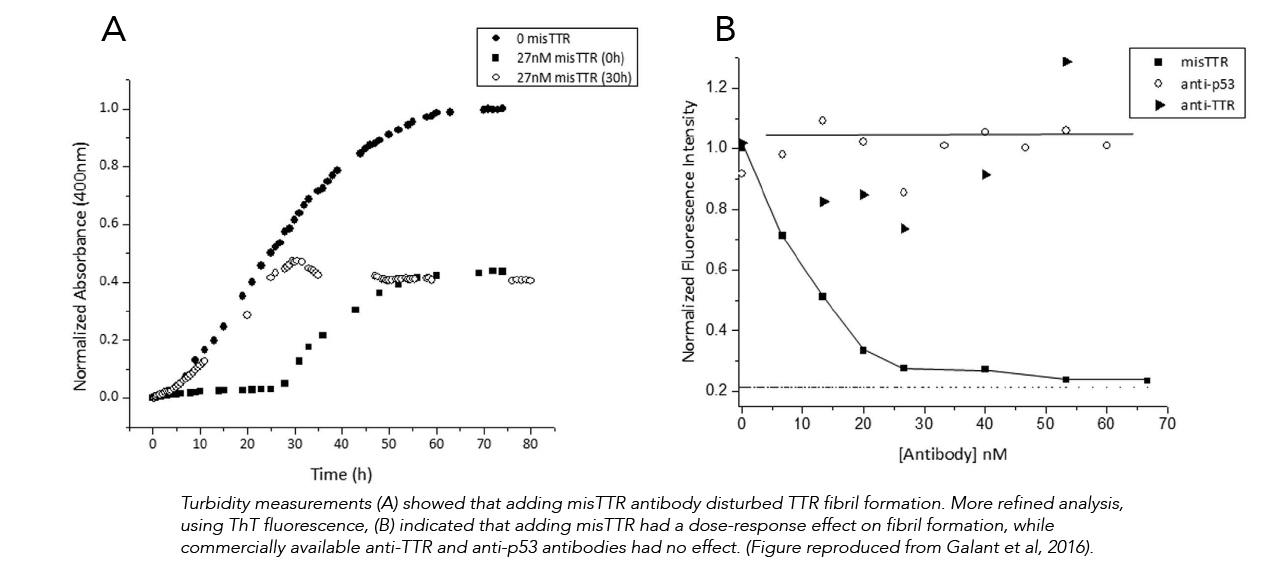Cyf Ramos-Colon Ph.D. Senior Scientist Gyros Protein Technologies
Protein misfolding can lead to abnormal conformations, fibril formation, and aggregation that cause severe conditions such as amyotrophic lateral sclerosis (ALS), prion diseases, and Alzheimer’s disease. Wild-type and mutant transthyretin (TTR), for example, can misfold and deposit in tissues to cause amyloid disease. Small-molecule drugs aimed at this disease act as pharmacological chaperones that inhibit TTR misfolding by stabilizing native tetrametric TTR, but have severe side effects or must be administered at high concentrations. Natalie Galant and Antoinette Bugyei-Twum, University of Toronto, together with Rishi Rakhit, Stanford University, and other researchers have tested a novel approach to solving this problem. They harnessed the specificity of antibodies using a “structurally guided” design to target a sequence that is buried deep in natively folded TTR, but exposed in misfolded and monomeric forms. The result is a diagnostic and potential therapeutic antibody that functions at substoichiometric concentrations to inhibit amyloid formation.
Therapy Transitions from Small Molecules to Antibodies
Transthyretin (TTR) is an abundant homotetrameric protein that transports thyroid hormones and vitamin A. Dissociation of the TTR tetramer into misfolded monomers results in the formation of amyloid fibrils that cause a number of amyloidoses. Treatment of these amyloidoses has recently been complemented with two small-molecule drugs, diflunisal and Tafamidis®, that act as pharmacological chaperones that directly bind to TTR’s thyroxine binding site. Diflunisal, however, has significant NSAID-associated side effects. Tafamidis has no NSAID-associated side effects but binds TTR relatively weakly, with an apparent dissociation constant in the micromolar range, which means that high concentrations are needed to reach binding saturation and prevent misfolding.
While small-molecule drugs like Tafamidis may be relatively easy to synthesize and administer orally, antibody drugs are promising in the field of misfolded proteins due to their specific mechanisms of action, fewer side effects, and higher drug approval rates. Antibodies have already been used as structural probes to investigate the misfolding of amyloidogenic and non-amyloidogenic proteins associated with ALS, prion diseases, and Alzheimer’s disease.
Natalie Galant and her colleagues therefore decided to develop an antibody that would specifically target the rare pre-fibrillar, misfolding intermediates of TTR without binding to the correctly functioning, natively folded protein. The high specificity should enable the drug to inhibit fibril formation at nanomolar levels—levels far lower than with, for example, Tafamidis.
Structural Analysis Guides the Way
The team examined the x-ray crystal structure of TTR and found that residues 89–97 comprised the longest segment that was hidden deep in the native tetrameric fold. They reasoned that an antibody directed toward this segment would ignore the correctly folded protein but bind to the low levels of misfolded TTR and monomeric and oligomeric forms at a substoichiometric concentration. Using a PS3 automated solid-phase peptide synthesizer, the team synthesized a multiple antigenic peptide (MAP). Each branch of the dendritic core contained the nine-residue sequence together with a total of six additional N/C-terminal residues that resembled the TTR sequence with increased size, thereby enhancing the immunogenicity of the peptide. They called the antibody directed against this MAP “misTTR”. Tests using ELISA and Western blotting confirmed that misTTR bound preferentially to monomeric and unfolded TTR rather than native tetrameric TTR. Immunohistochemistry analysis also confirmed that misTTR bound to cardiac amyloid deposits from a patient with an I84S TTR mutation.
Substoichiometric Concentrations of misTTR Hinder Fibril Formation
TTR fibril formation is a nucleated polymerization process with a lag phase when the amyloidogenic intermediate is formed followed by a rapid growth phase. Adding the misTTR antibody at time zero disturbed this process, resulting in reduced aggregation: only 40% of that seen in the absence of antibody (Figure 1A). The team refined the analysis by using ThT fluorescence, which specifically measures the formation of amyloid fibrils. They saw a striking dose dependent inhibition of TTR fibrillogenesis, with an IC50 of approximately 9 nM (Figure 1B), compared to no inhibition by commercially available anti-TTR and anti-p53 antibodies.
Conclusions
The systematic, structure-guided approach used by this research team has resulted in a highly specific antibody that will be a valuable tool to probe the structure of misfolded intermediates, diagnose TTR-related amyloidosis patients, and perhaps even become a therapeutic agent. This approach could also be applied to similar diseases involving oligomeric misfolding.

Figures 1A and B
Reference
Substoichiometric inhibition of transthyretin misfolding by immune-targeting sparsely populated misfolding intermediates: a potential diagnostic and therapeutic for TTR amyloidoses. Galant NJ, et al. Sci Rep. 2016 Apr 28;6:25080. doi: 10.1038/srep25080.
See also:
Corrigendum: Substoichiometric inhibition of transthyretin misfolding by immune-targeting sparsely populated misfolding intermediates: a potential diagnostic and therapeutic for TTR amyloidoses. Galant NJ, et al. Sci Rep. 2016 Jun 10;6:27679. doi: 10.1038/srep27679.
Cyf Ramos-Colon, Ph.D. ([email protected]), is a senior scientist at Gyros Protein Technologies.



